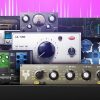-
 play_arrow
play_arrow
Clubalicious Clubalicious Radio
-
 play_arrow
play_arrow
London Calling Podcast Yana Bolder

So many new pro audio and music products are released each year that it becomes difficult to make fair comparisons or put together a “Best Of” or “Top 25” list. How do you choose when presented with a new $10,000 single-channel analog compressor and a $79 distortion plug-in? In that spirit, please consider this our annual “Must-Have” list, where there’s something for every type of audio pro.
To put together this year’s selection, we asked longtime Mix contributors and product reviewers Steve La Cerra, Mike Levine, Rich Tozzoli, Barry Rudolph and Michael Cooper to send in a few of their favorites. Here, presented in alphabetical order, are those selections (Don’t Pass Up Parts 1 and 2!)
SENNHEISER MD421 KOMPAKT

If this little guy looks familiar…well, it should. The MD421 Kompakt intends to deliver the performance and signature sound of the venerable Sennheiser MD421/MD421-II microphones in a smaller package, with a redesigned mounting clip.
Like its namesake, the MD421 Kompakt is a large-diaphragm dynamic microphone that can handle high sound pressure levels and is appropriate for use on a variety of sources, including drums, horns and instrument amplifiers. The pickup pattern is cardioid, and frequency response is stated as 20 Hz to 17 kHz. The 421 Kompakt is less than half the weight of the classic 421 (5.6 vs. 13.6 ounces) and just a bit longer than half the size, making it easier to place in tight quarters.
Features include a mounting clip integrated with the mic body, an internal bass tube that ensures accurate and extended low-end response, a rugged frame with stainless steel basket, and a protective inner chassis enclosure that minimizes exposure to dust and humidity.
The MD421 Kompakt will live side by side with the original MD421, which was introduced in 1960(!). Both microphones employ the same capsule, but the Kompakt omits the five-position low-frequency rolloff switch featured on the standard MD421, allowing the Kompakt’s low- frequency response to behave in a manner similar to that of the standard MD421 with the switch set to “M” (Music).
Available as a companion to the MD421 Kompakt is the optional MZH Drum Clamp, which securely screws into the Kompakt mounting clip to create a versatile and secure mechanism for securing the mic on the rim of a drum. A quick audition of the MD421 Kompakt alongside the standard MD421 indicated that the two are definitely members of the same family. Stay tuned for the full review! —Steve La Cerra
SENSAPHONICS DB CHECK PRO

A dB meter or app can measure the SPL from your studio monitors to help you listen at safe levels, but before Sensaphonics released dB Check Pro, there was no easy way to do the same when monitoring on headphones or wearing in-ear monitors.
The dB Check Pro is a small, in-line device that connects your IEMs or headphones to the monitor source (mixer, audio interface, etc.) without affecting the sound. It supports more than 140 headphone and IEM models from various manufacturers, and more will be added via firmware updates. A Mix reviewer found the product, which is about the same size as a wireless pack and attaches with a belt clip, easy to set up and use. It runs on a lithium-ion battery that can provide 11 hours of operation when fully charged.
A pair of 1/8-inch jacks connect dB Check Pro between your sound source and headphones/ IEMs. Sensaphonics built a microphone into dB Check Pro to capture ambient sound levels in the room.
The front-panel color screen is bright and pressure-sensitive rather than touch-sensitive, a deliberate design decision. Because the former requires more pressure, an inadvertent tap from your fingers is less likely to change a setting accidentally.
You can set dB Check Pro to display the SPL coming through your headphones or IEMs, the room levels, or both. Based on NIOSH and OSHA standards, the display shows average dBA-SPL levels and calculates your safe listening time at a specific volume.
Thanks to dB Check Pro, you no longer have to guess whether the SPL coming through your headphones or IEMs is damaging to your hearing. —Mike Levine
SHURE WMAS (WIRELESS MULTICHANNEL AUDIO SYSTEM)

As the Federal Communications Commission continues to restrict the RF spectrum available for use by the entertainment industry, the challenge flag has been thrown: How do we fit more channels of wireless audio into less bandwidth while maintaining robust operation? WMAS appears to be the solution, providing highly efficient use of available RF spectrum.
Shure WMAS is a wideband digital transmission technique that combines wireless mics, instrument systems and IEMs into one broadband RF channel. The bandwidth of the RF channel can vary but is limited to a maximum of 20 MHz, with a capacity of at least three audio channels per 1 MHz of bandwidth. WMAS achieves this by reducing the minimum channel spacing between adjacent audio channels and by utilizing a broadband multi-carrier transmission method that combines several audio channels into one broader radio channel.
WMAS is scalable, meaning that the RF bandwidth can be adjusted depending upon the required number of audio channels, which improves RF efficiency and enables WMAS to be combined with traditional narrowband systems, or adapted to the availability of unused spectrum at a particular time/location.
Earlier this year, the FCC and CEPT (the European equivalent) adopted regulatory changes that permit wireless microphone systems to use spectrum blocks wider than 200 kHz, provided the equipment uses the spectrum efficiently. Using these wider blocks, a single frequency can be used to operate multiple wireless channels.
Shure just announced its first WMAS-enabled product, the Axient Digital PSM, in October, and the technology promises to be a solution for major events requiring high numbers of wireless channels. Plus, the bidirectional nature of WMAS means that a single body pack could simultaneously be used for wireless IEMs and a microphone or instrument! Stay tuned… —Steve La Cerra
SONY MDR-M1 CLOSED MONITOR HEADPHONES

Sony keeps pushing the boundaries of headphone technology with the release of the MDR-M1 Closed Monitor Headphones. A definite sonic step up from the classic MDR 7506s, which were introduced in the early 1990s and found a home in countless studios, the MDR-M1s are significantly lighter and more comfortable.
The listed spec is 5 Hz – 80 kHz. Hmmm, not sure what to say about hearing 80kHz, except I like the accurate clarity of the top end on these, and the bass notes have an impact. The MDR-M1 features 50-ohm impedance, so they drive easily, a detachable 1/8-inch mini and 1/4-inch cable, and 40mm driver. They weigh only .47 pounds.
For full disclosure, I use and love the Sony MDR-MV1 headphones on a daily basis, both for tracking and mixing. I even do accurate, full 5.1 mixes on them with the Sony 360 VME Virtual Mixing Environment. However, the issue that does pop up, since they are open-back, is the bleed that can happen when tracking, especially when there’s a loud click track.
With the closed-back MDR-M1s, I can track with that loud click and it’s no problem. Most importantly, they still give me that fidelity I want to hear, which makes for a better performance. The M1s exhibit similar general characteristics to the MV1s in that they sound great and you can use them for long stretches of time without ear fatigue. I appreciate that the pads are super-soft and they have a tight but comfortable feel.
I noticed in a direct comparison that the bass impact hits you harder compared to the MV1s, and there is a “proximity” to the sound that is more like the 7506s. It’s almost like a middle-ground hybrid between the two.
The MDR-M1s have found a place in my workflow, allowing me a high-fidelity tracking/production experience with good isolation and accurate, detailed sonic performance. Also, the design features replaceable hardware elements, which is invaluable for studio use (we all know what can happen!). —Richard Tozzoli
SOUND DEVICES ASTRAL WIRELESS GUITAR SYSTEM

Sound Devices made a rather quiet-yet-splashy entrance into the wireless market with the launch of the Astral Wireless Guitar System, designed specifically for guitar and bass.
The system consists of the company’s A20-TX Transmitter with A20-TX Guitar Strap Clip, A20-TX Smart Guitar Cable, and A20-Nexus True-Diversity Wireless Receiver. At the heart of the system is the A20-TX Smart Guitar Cable, which incorporates proprietary circuitry within the 1⁄4-inch instrument plug and allows user-adjustable capacitance and impedance, ensuring that the instrument’s pickups are loaded the same way with the wireless transmitter as they would be if they were plugged into an instrument amplifier.
Using the A20-TX Smart Guitar Cable, the system can handle an input level of 18V peak-to-peak(!), and provides a dynamic range of 140 dB, making it appropriate for use with active “hot” pickups. Output from the 1⁄4-inch instrument connector to the transmitter input is balanced, ensuring low-noise operation.
Transmission is proprietary, 100% digital RF modulation with long range and an audio bandwidth of 10 Hz to 20 kHz (±1 dB). Transmitter power may be set to Low (2 mW), Normal (10 mW), High (20 mW) and Extra High (40 mW). Latency is stated to be 1.9 mS.
A20-Nexus True-Diversity Wireless Receivers are capable of packing 8 channels in a half-rack chassis, expandable to 12 or 16 channels via A20-Nexus 4-Channel Expansions. Audio output is via Dante or dual DB25 connectors carrying mic, line or AES output, and the A20-Nexus receiver is capable of converting 16 channels of Dante to mic- or line-level analog audio and/or AES via the DB25s. The unit supports sample rates of 44.1, 48 or 96 kHz. —Steve La Cerra
COME BACK TOMORROW FOR THE CONCLUSION!
Written by: Admin
Similar posts
Recent Comments
No comments to show.Featured post

Latest posts
Current show
Upcoming shows

Made To Move
Jacob Colon
19:00 - 20:00
In Session
Sister Bliss
20:00 - 21:00
Fresh Is Fresh
This Weeks Hottest Releases
21:00 - 00:00
Uplifting Only
Ori Uplift
00:00 - 02:00
Fresh Is Fresh
This Weeks Hottest Releases
02:00 - 09:00Chart
Powered by Dee jay promotions visit us













 Invalid license, for more info click here
Invalid license, for more info click here